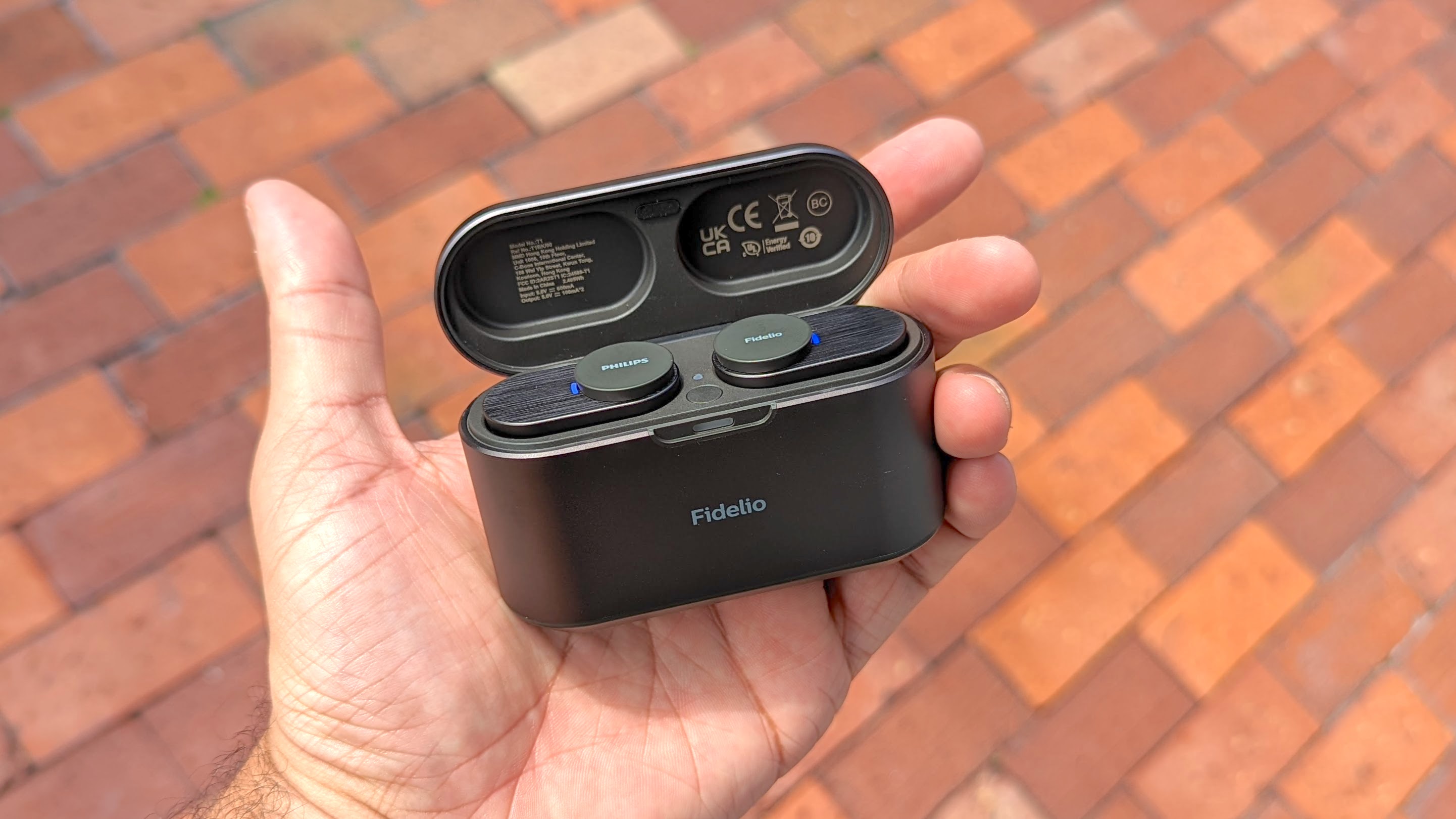Laptop Mag Verdict
If not for numerous bugs and terrible connectivity, the Philips Fidelio T1 could have been notable luxury wireless earbuds.
Pros
- +
Very powerful ANC
- +
Satisfying sound with LDAC codec support
- +
Long battery life
- +
Chic design
Cons
- -
Poor connectivity
- -
Lots of bugs
- -
Unreliable controls
- -
Loose-fitting and uncomfortable
- -
Expensive
Why you can trust Laptop Mag
The Philips Fidelio T1 is the latest flagship model released by the multinational electronics giant. On paper, these wireless earbuds have the makings of an elite product. Three-level active noise cancellation with strong wind resistance. Rich, natural sound delivered through a 10mm dynamic driver with balanced armature unit. Extended playtimes that surpass many of the market’s best wireless earbuds. And a gorgeous design composed of premium materials.
Price: $299
Colors: Black; White
Battery life (rated): 9 hours (ANC on); 13 hours (ANC off); 33 hours (charging case with ANC on); 48 hours (charging case with ANC off)
Connectivity: Bluetooth 5.2
Water resistance: Yes (IPX4 rated)
Size: 2.0 x 3.3 x 1.2 inches (charging case)
Weight: 3.84 ounces (earbuds + charging case)
However, the blemishes start to show the moment you press play, many of which ruin the true wireless experience. How can a model this well-engineered on the audio and ANC ends be such an operational disaster?
This is where these buds went wrong.
Philips Fidelio T1 availability and price
You can purchase the Fidelio T1 for $299 at major online retailers, including Amazon and B&H, or directly from Philips. Two colors are available: Black and White. Inside the box comes a wireless charging case, USB-C charging cable, six pairs of different sized silicone tips, three pairs of different sized Comply Foam tips, and a quick guide.
These buds are pricier than the category’s top three offerings: the AirPods Pro ($249), Sennheiser Momentum True Wireless 3 ($249), and Sony WF-1000XM4 ($279). If the MSRP is too high, consider sub-luxury rivals like the Marshall Motif A.N.C. ($199) or Beats Fit Pro ($199).
Be sure to bookmark our headphone deals page for the latest sales.
Philips Fidelio T1 design and comfort
Besides the elongated form, everything about the Fidelio T1 is attractive. Philips craftsmanship stands out, having constructed these buds from durable plastic, soft rubber, and sturdy aluminum. Details like the protruding touch panels, tiny LEDs, and glimmery finish are nice touches. Even the colorways look fancy, specifically the white version, which is more like a combination of slate grey and silver instead of white.

These buds are stored in a huge charging case that is practically one huge block of aluminum. It’s built to take a beating, looks high end, and displays the buds handsomely on the inside. At the same time, the size makes it inconvenient to carry around. Trust me when I say you’ll risk tearing the fabric of your denim jeans if you attempt to stuff it into your pockets.
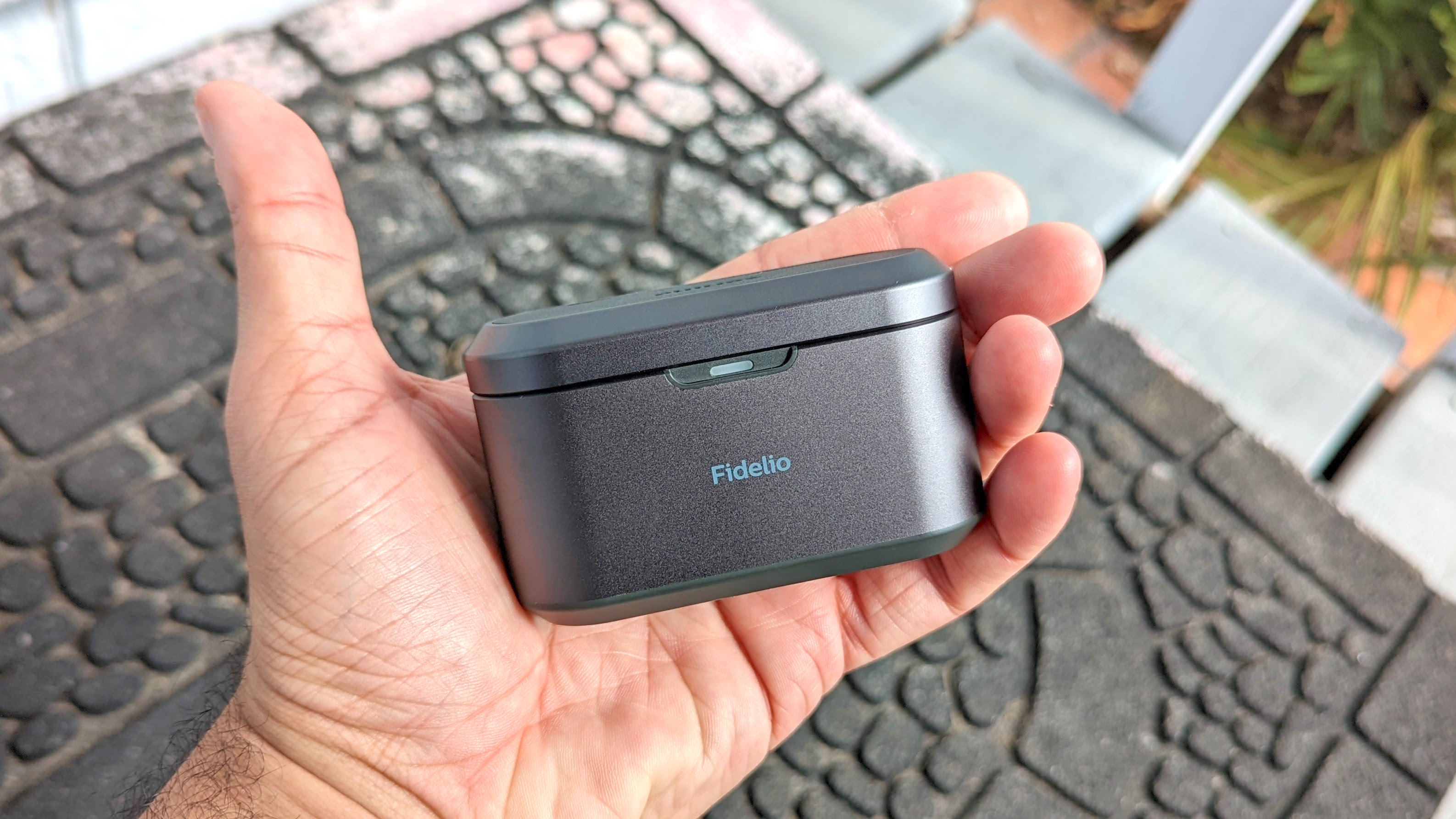
As good-looking as the Fidelio T1 is, it’s a bit uncomfortable and provides a loose fit. Philips doesn’t share the buds’ weight, but they do list the product’s total weight at 3.84 ounces, which is heavy to carry around. The buds feel hefty compared to featherweights like the AirPods Pro (0.19 ounces). Wearing them for over an hour was fatiguing on the concha.

The silicone tips provided little grip control and the buds occasionally slipped out when walking around. Also, these tips felt slicker than others; swapping them out was a hassle. Philips added extra Comply Tips that work much better, though installing them was an infuriating task. Trying to squeeze a circular design (tips) to fit onto a long oval design (the sound part) isn’t fun.
Philips Fidelio T1 controls and digital assistant
Philips’ control scheme is a bit odd. You get access to most controls directly on the buds, as well as motion detection for auto-pause. However, the controls aren’t the problem. It’s the inputs and overall functionality.
Rather than assign a standard input like single tap to play/pause, Philips programmed this function to a 1-second hold gesture, which is peculiar to say the least. The quick guide claims that the left and right buds accept single and multi-tap inputs, but my testing said otherwise. My left bud just stopped recognizing touch input after two hours of use. I reset the buds and it happened again.

When the buds did acknowledge taps or holds, touch accuracy was off and intended commands were rarely executed. I can’t forget to mention that there is no way to customize the controls either.
If you can somehow get the digital assistant to turn on via the left bud, then you’ll be rewarded with dependable voice assistance. Siri and Google Assistant picked up commands well, thanks to Philips intelligible mic array that demonstrated strong speech recognition. I must warn you that using it could mess up the controls, at least that was my experience (more on this in the connectivity section).
It seemed like the only thing that worked properly was motion detection. Music stopped when removing the buds and resumed playback when placing them back on my ears.
Philips Fidelio T1 audio quality
The Fidelio T1’s sound profile comes neutral out of the box. You can personalize it by either enabling ANC, which gives bass a significant boost without affecting mids or highs, or by selecting from four different presets in the companion app: Bass, Voice, Powerful or Treble. Each one emphasizes different parts of the soundstage, something that has its pros and cons. I found the default profile to be the best option for dynamic, well-balanced sound, though the midrange took a hit on certain tracks.
On melodic hip-hop tracks like Smoke DZA and Pete Rock’s “Hold the Drums,” the mids and highs were accentuated and came through clearly. I could hear and feel every vibration from the rattling cymbals, while the smooth piano sample and upright bass were reproduced exceptionally well for a peaceful listen.
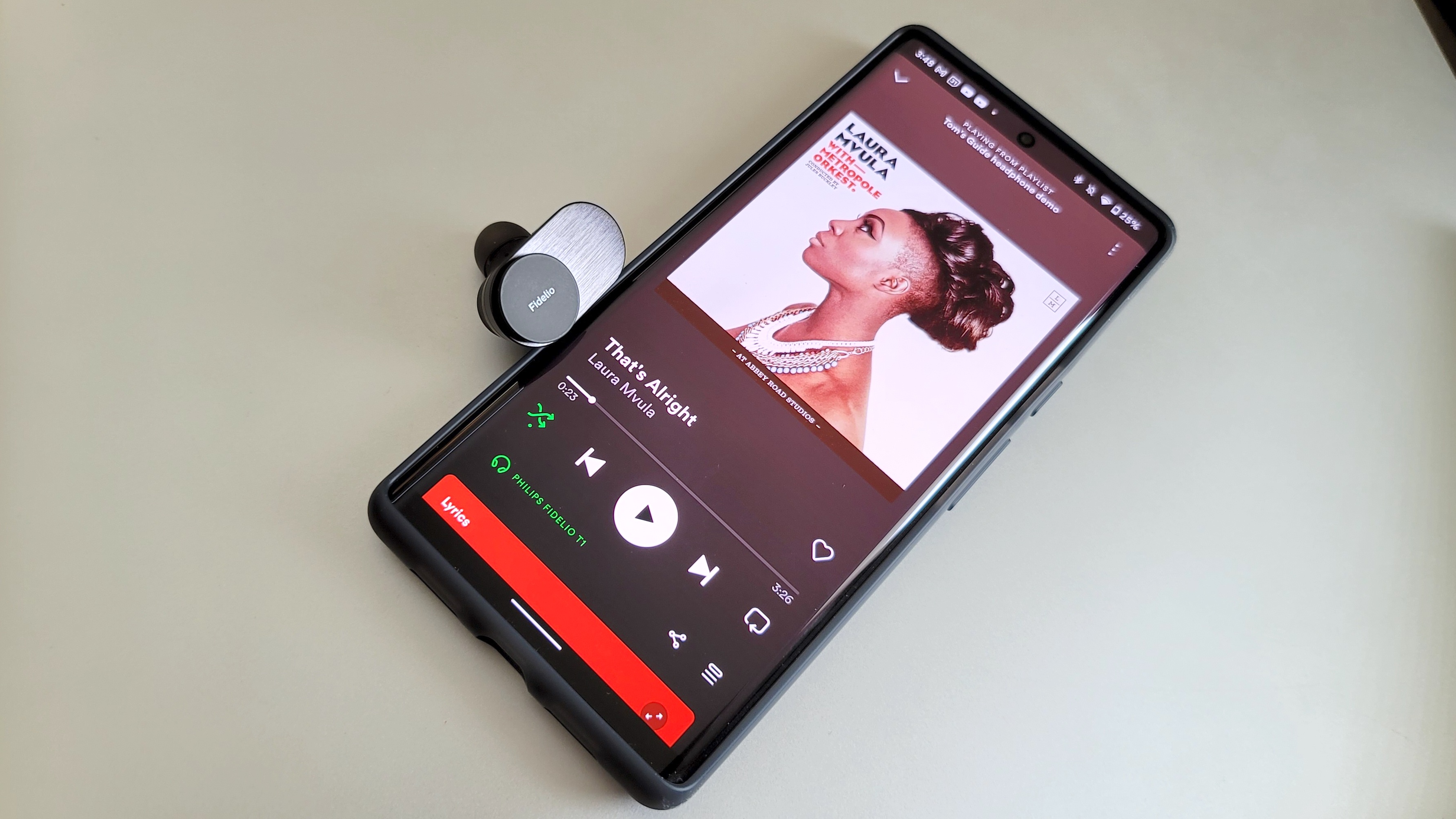
The orchestral production on Laura Mvula’s “That’s Alright” sounded fantastic, with the warring drums having great bounce and maintaining their presence over the soaring string arrangements. It was impressive to hear highs receive such prominence, but more disappointing that the vocals were veiled during the chorus.
Thinking this would be the same for all orchestral-driven records, I played Aretha Franklin’s version of “I Say a Little Prayer” with the Royal Philharmonic Orchestra and was thrilled with the Fidelio T1’s resolution. The Queen of Soul and her background singers sounded distinctive, serene, and crisp over the violins.
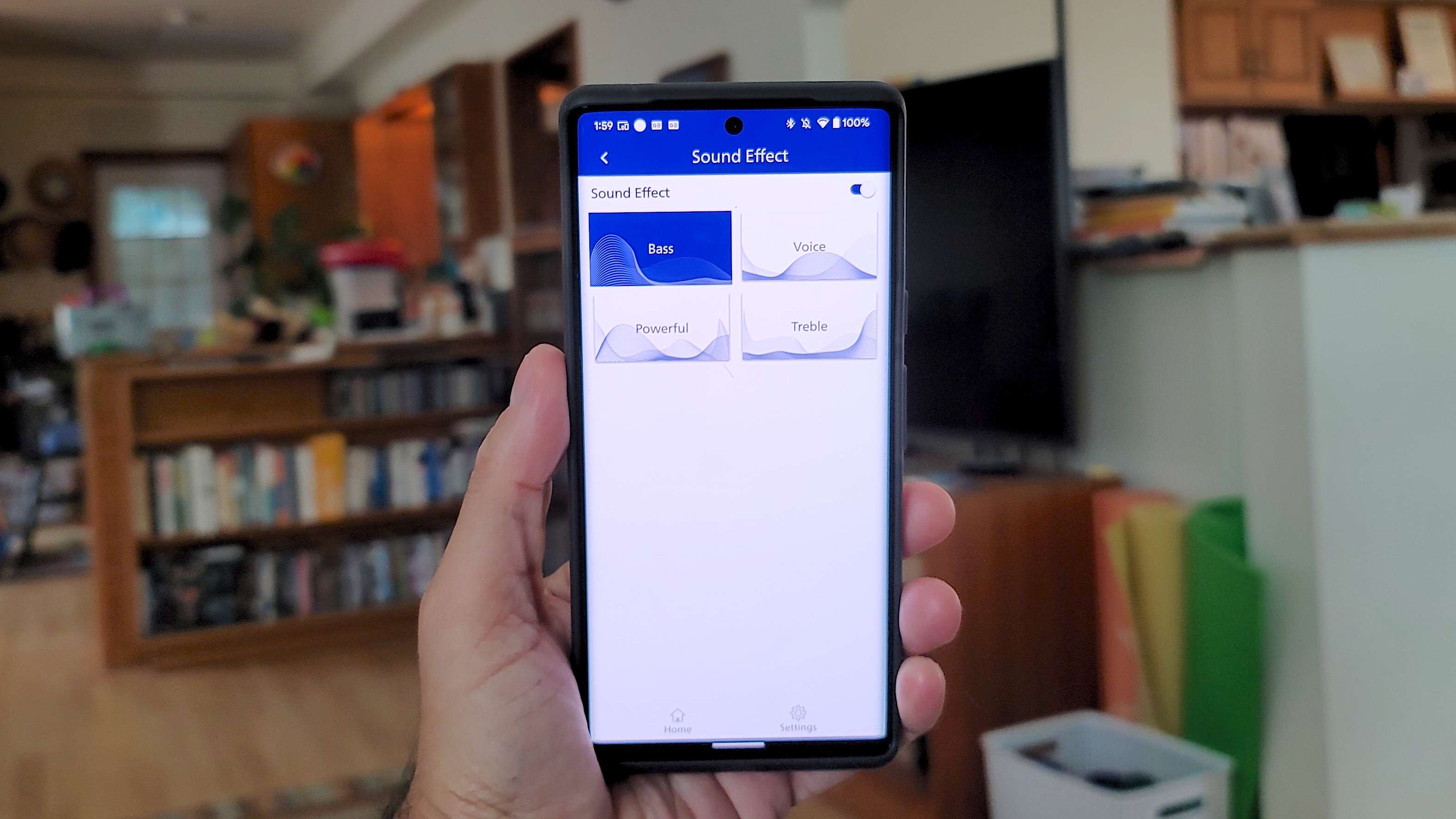
Supported audio codecs include AAC, SBC, and LDAC, the latter being a premium feature that not many wireless earbuds come with, and was designed for audiophile-grade streaming over Bluetooth. I used my Google Pixel 6 Pro to test the feature and found the streaming speeds significantly faster than when listening on any iOS/macOS device.
AAC performed badly, especially on my MacBook Pro, where music files and select songs on Apple Music lacked clarity. Lo-fi recordings sounded bloaty and there was lag when playing Spotify tracks.
Philips Fidelio T1 active noise cancellation
These are some of the more versatile noise-cancelling earbuds you’ll find out there. Philips created both a three-level ANC mode and robust Awareness mode to give users complete control over how much noise they want to block out or let in.

Selecting ANC in the companion app greets you with three options – High, Low, and Wind Noise Reduction – each engineered for different purposes. High is most useful against loud noises, while Low is best suited for blocking out voices. Wind Noise Reduction is self-explanatory. They all worked surprisingly well. I spent most of my testing time with High enabled and found it useful for muting common distractions like FedEx deliveries, iPhone ringers, loud TVs, and overly chatty family members. There was no avoiding my toddler’s joy-filled shrieks or whistles, but the buds can handle some high-frequency noises like bird chirps.
Wind Noise Reduction performed a lot better than I thought it would. Turning it on diminished the whisking effects produced in gusty conditions, so the music sounded clearer. Speeding cars could still be heard, though they weren’t disruptive when listening to music in front of the house.
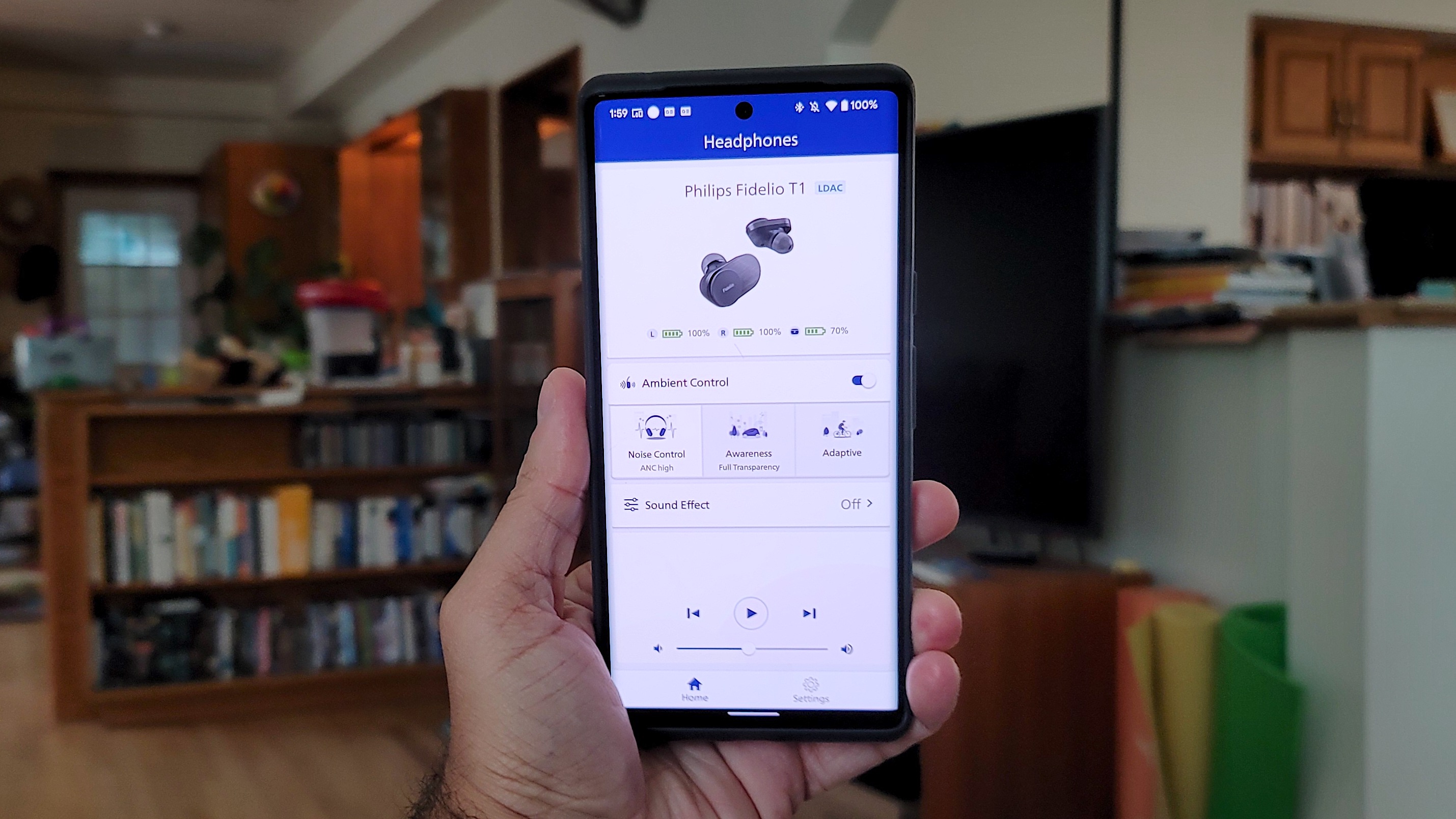
Awareness comes with four adjustable levels of ambient listening. Setting it to max (level 4) opens the mics fully to hear every single peep around you. Well, not every peep (you’re not going to hear a mouse run across the floor), but the buds pick up incidental noises well enough to give listeners a greater sense of environmental awareness. The mode came in handy when watching my baby boy during nap time via monitor and during morning strolls where traffic volume was high. There is a Voice Mode that emphasizes vocals, and it is serviceable for when you want to hear people speak clearly without pressing pause or removing the buds.
Philips Fidelio T1 app and special features
The Philips Headphones app is the main hub for extended functionality. Here is where you’ll go to access all the Fidelio T1’s special features, including the aforementioned ANC/Ambient Control modes and presets. There isn’t much else to play with.
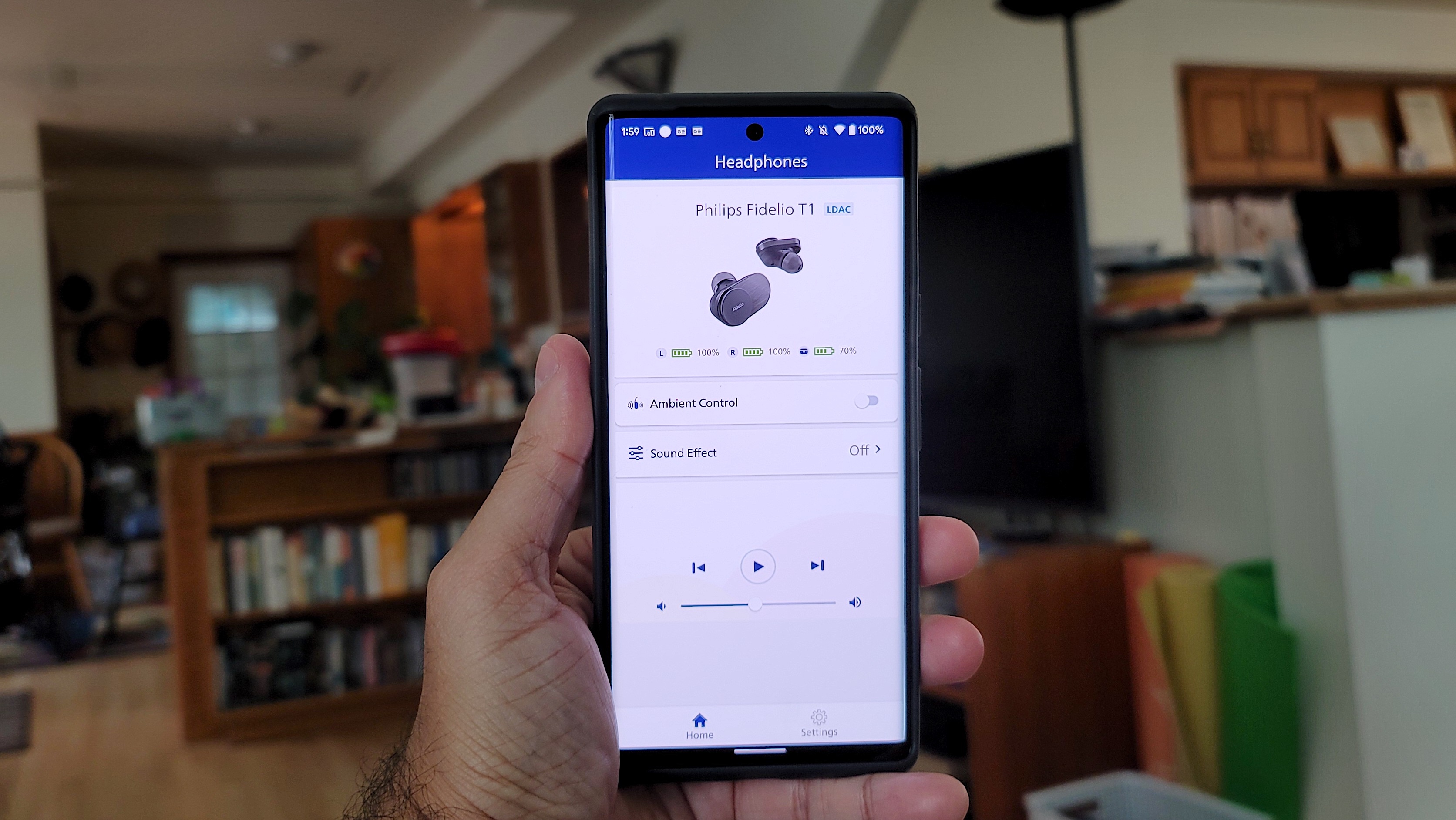
Aside from battery level indicators for both buds and the charging case, you’ll stumble upon a few toggles to enable different functions (e.g., multi-connection, voice assistant), a music player, a visual guide, and an Auto-Off setting to place the buds in sleep mode when inactive after a certain amount of time.
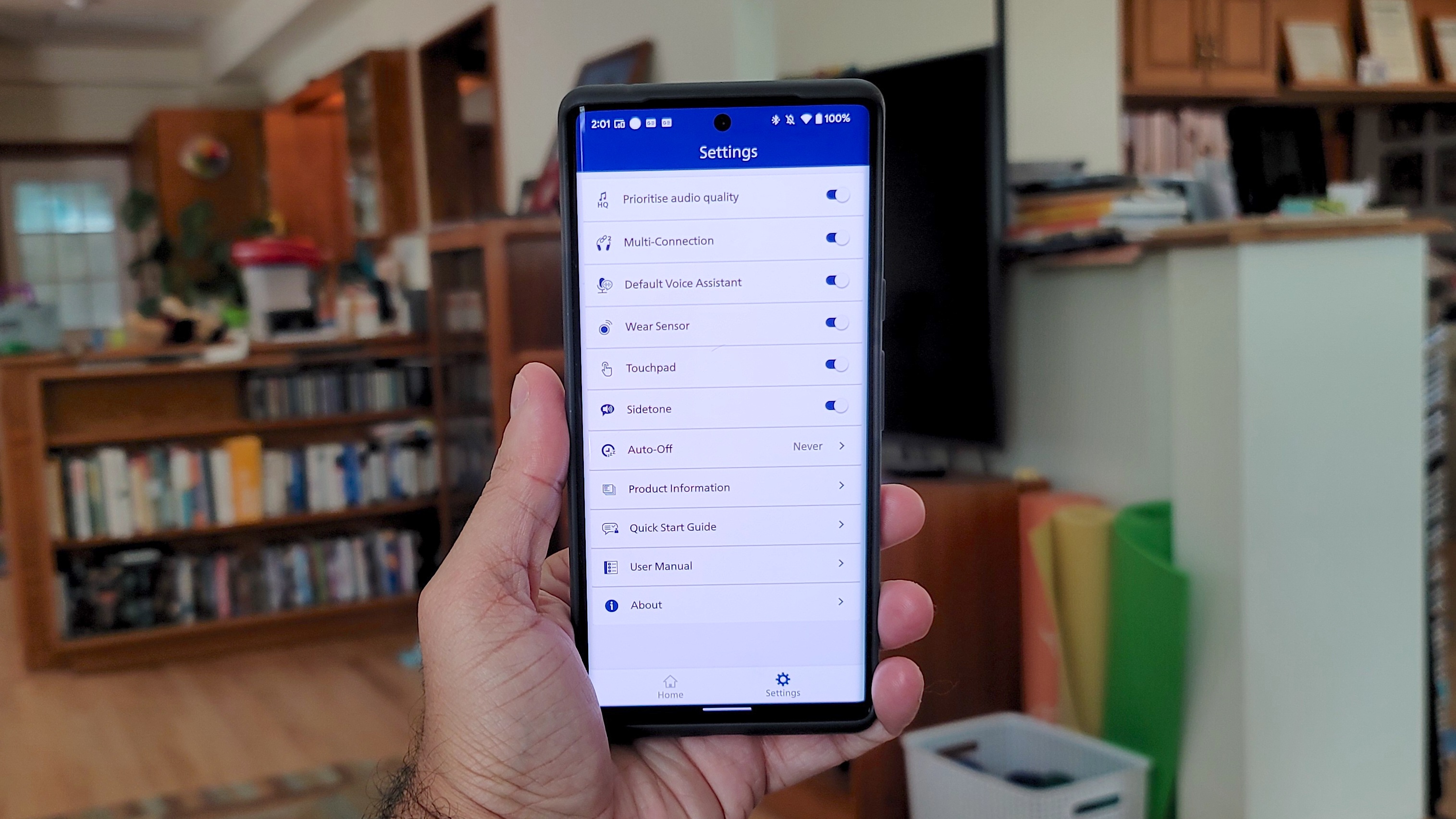
This is a decent number of features to have. If only the app wasn’t so buggy. There were times when it wouldn’t recognize the buds, and if it did, then a connection would occur that caused the program to crash. I was met with a retry prompt many times and pressing it always force-closed the app. Bear in mind that all of this occurred before and after I downloaded the latest software update.
Philips Fidelio T1 battery life and charging case
Another strength of the Fidelio T1 is playtimes. A full charge gets you between 9 hours (ANC on) and 13 hours (ANC off), some of the longest battery life in the category. This beats out the Sony WF-1000XM4 (8 to 12 hours), but is also shorter than bargain gems like the $100 JLab Epic Air Sport ANC (11 to 15 hours). Factor high volume and LDAC into the equation, these playtimes drop by about 1 to 2 hours. Nonetheless, you’re given plenty of listening time to work with. I had no complaints about the 4 days of moderate use (2.5 hours daily) the buds provided.
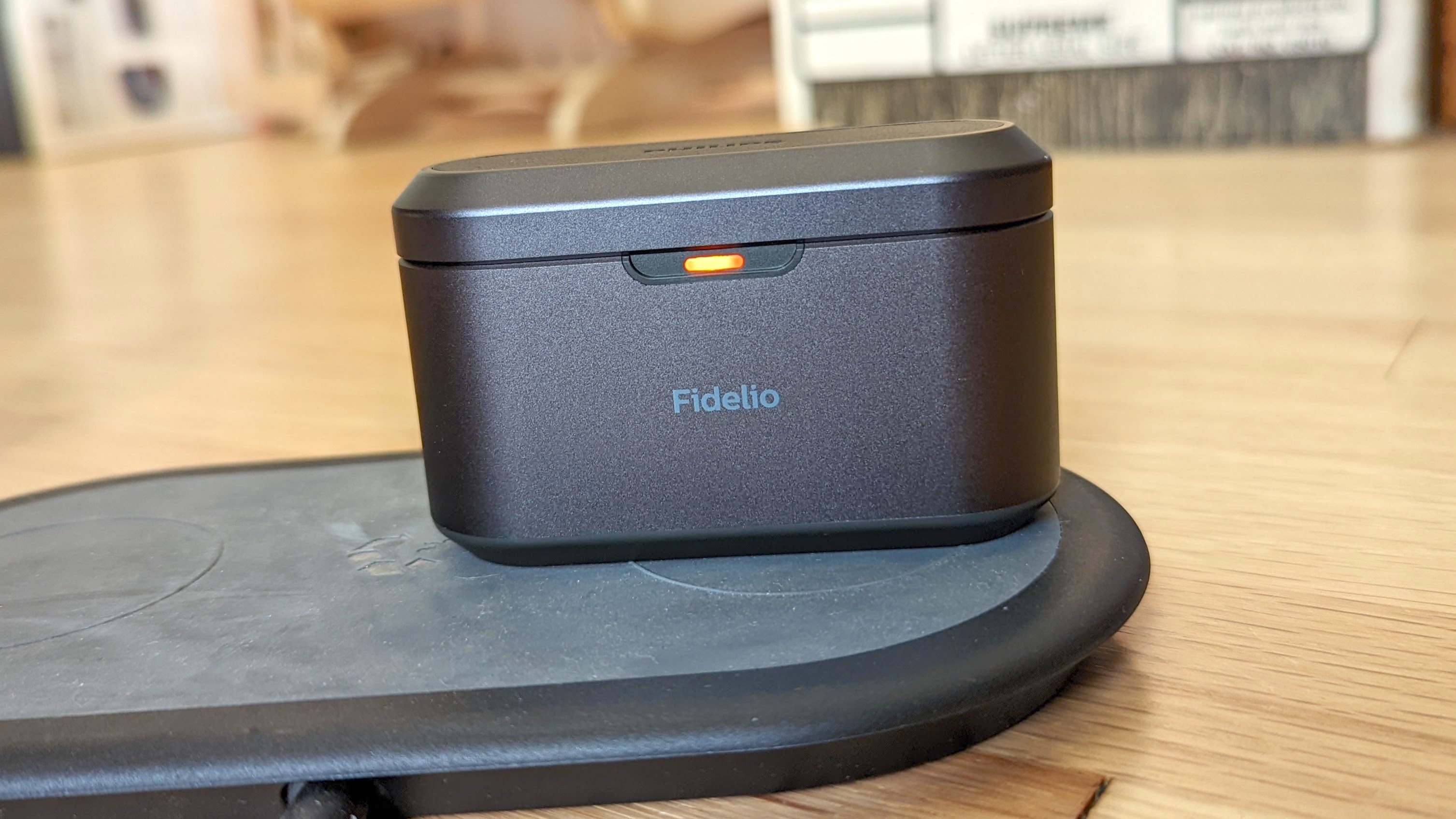
The charging case holds up to a whopping 48 hours, depending how you use the buds. That’s basically double what the AirPods Pro case offers: 24 hours. If there is a complaint, it’s that quick charging could be better: 15 minutes in the case generates only 1 hour of use.
Philips Fidelio T1 call quality and connectivity
The Fidelio T1 is a sufficient calling headset. Any calls I took indoors sounded loud and clear. Outdoors was a mixed bag; several people mentioned minor muffling when speaking from the backyard. That effect got worse when walking to the house, as landscaping tools and speeding cars created lots more interference. Wind resistance was the biggest culprit and made it impossible to hold a conversation.
Now comes the part where I discuss the absolute worst thing about these buds: connectivity. As for what’s good, that would the range (up to 40 feet). Everything else is awful.

I couldn’t enjoy the multipoint technology because the connections would scramble between devices and produce this harming static noise that goes away only when disconnecting from the troubling audio source. There were times when the buds would randomly pause. Other times, the left bud just stopped playing audio completely; this seemed to happen every time auto-pause was enabled and playback resumed. I thought unpairing and re-pairing the buds would fix this. It didn’t. The same problem occurred on the right bud after firing up the digital assistant on my Google Pixel 6 Pro.
Philips has Google Fast Pair listed on the spec sheet. Well, not once did I see the one-tap pairing prompt appear on any of my Android devices: Pixel 2 XL, Pixel 6 Pro or Samsung Galaxy Note S22 Ultra.
Bottom line
I’m sorry, but great sound and noise cancellation aren’t enough to justify the Fidelio T1’s calamities. If by some miracle a software update could miraculously fix the several connectivity issues, unreliable controls, and flush out all the bugs, then these buds may be worth revisiting. But even then, the competition is just too stiff at their expensive price point.
The better noise-cancelling investment is by far the Sony WF-1000XM4 or Sennheiser Momentum True Wireless 3, two models that do everything better than the Fidelio T1 and cost less.
Alex Bracetti writes about all things related to audio at Laptop Mag. From insightful reviews of Sony earbuds to hands-on experience with the Beats Studio Pro, Alex covers everything you need to know in order to buy the best pair of headphones or earbuds. Alex has also written about speakers and audio apps. Outside of Laptop Mag, Alex's work has appeared in our sister site Tom's Guide.
